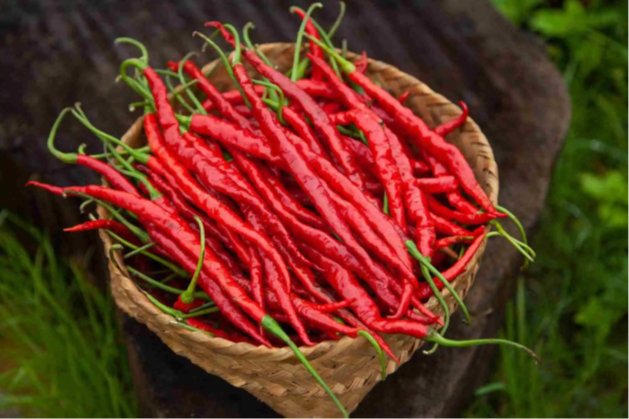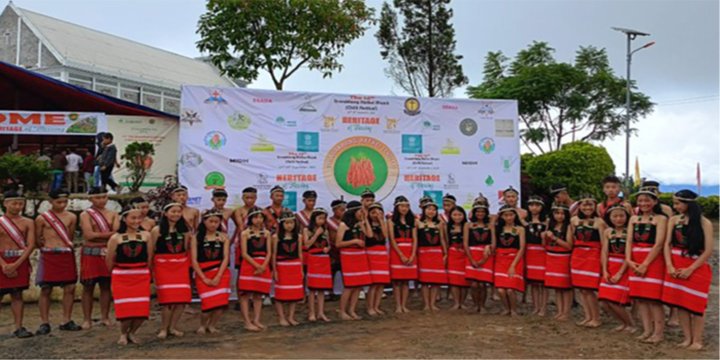14 SIRARAKONG HATHEI CHILLI FESTIVAL
- The 14th Sirarakhong Hathei Chilli Festival was held on 16 September 2025 in Sirarakhong village, located in Ukhrul District of Manipur.
- This annual event celebrates the Geographical Indication (GI)-tagged Hathei Chilli, a unique and indigenous chilli variety cultivated by the Tangkhul Naga tribe.
- The festival was organised under the broader framework of the Azadi Ka Amrit Mahotsav, a nationwide initiative to commemorate 75 years of India’s independence and promote local heritage.
- The event was inaugurated by Thaithuilung Pamei (IAS), Commissioner of Horticulture & Sericulture, Government of Manipur. Other key attendees included Sword Vashum, President of Tangkhul Naga Long, Wungkhayap Zimik, Headman of Sirarakhong village, and Ngamreiwung Luithui, Sub-Divisional Officer (SDO), LM Block.
- This festival is not merely a cultural celebration but also a platform to promote agro-entrepreneurship, GI-based branding, tribal empowerment, and national integration.
- It highlights the importance of conserving indigenous crops as tools for sustainable rural development and cultural preservation.
ABOUT HATHEI CHILLI
- Hathei Chilli, also known locally as Sirarakhong Chilli, is a distinct variety cultivated exclusively in the microclimatic conditions of Sirarakhong village in Manipur.
- The chilli is grown using traditional jhum (shifting) cultivation methods on the hill slopes by the Tangkhul Naga community.
- In 2021, it received the Geographical Indication (GI) tag, which formally recognised its unique place-based identity, quality, and reputation.
- The chilli is known for being mildly pungent yet highly aromatic, and it has an ASTA (American Spice Trade Association) value of 164, indicating its high extractable colour content and deep red pigment, which is highly prized in both domestic and international spice markets.

UNIQUE FEATURES & ECONOMIC SIGNIFICANCE
- The key distinguishing feature of Hathei Chilli is its bright deep red colour, which makes it suitable for colour extraction, pickling, and culinary use.
- Due to its exclusive dependence on local climatic and soil conditions, it cannot be replicated outside Sirarakhong.
- It also retains its flavour and pigment longer than most commercial chilli varieties, making it valuable in niche agri-markets.
- Economically, the chilli serves as the primary livelihood source for a majority of the village’s population.
- Its rising market demand is helping transform it into a GI-based rural brand, boosting agri-tourism, farmers’ incomes, and rural entrepreneurship.
- The chilli has become a rural economic multiplier, integrating traditional knowledge with modern market linkages.
CULTURAL IDENTITY & COMMUNITY ROLE
- Hathei Chilli is a significant part of the Tangkhul Naga tribe’s food culture, heritage, and rituals.
- Its cultivation, preservation, and use in local cuisine are deeply tied to tribal identity and pride.
- Over the years, the chilli has come to symbolise Manipur’s broader agricultural and cultural heritage, contributing to both community resilience and ecological sustainability.
HEALTH & NUTRITIONAL BENEFITS
- Apart from its cultural and economic importance, Hathei Chilli offers several health benefits.
- It is rich in antioxidants, which help reduce oxidative stress.
- The chilli contains high levels of calcium, important for bone and muscle health, and Vitamin C, which supports immunity and enhances iron absorption.
- Though not extremely hot, it contains small quantities of capsaicin, known for its anti-inflammatory and pain-relieving properties.
ABOUT GI TAG
- A Geographical Indication (GI) is a form of intellectual property right that identifies products originating in a specific location and possessing qualities or a reputation due to that origin.
- GI tags are governed under the Geographical Indications of Goods (Registration & Protection) Act, 1999.
- The GI Registry, under the Department for Promotion of Industry and Internal Trade (DPIIT), Ministry of Commerce and Industry, grants the GI tag.
- Products eligible for GI recognition include agricultural goods, foodstuffs, handicrafts, wines, and industrial products.
- In the North-Eastern region, several products have received GI tags, such as Bhut Jolokia (Assam/Nagaland – one of the world’s hottest chillies), Chak-Hao (black rice from Manipur, rich in anthocyanin), and Mizo Chilli (from Mizoram, known for its strong flavour).
KEY HIGHLIGHTS OF 14TH HATHEI FESTIVAL
- The 2025 edition of the festival included cultural performances showcasing Tangkhul heritage, a Buyers–Sellers Meet to connect farmers with markets, a tree plantation drive under the national campaign “Ek Ped Maa Ke Naam”, and a photo exhibition organised by the Central Bureau of Communication (CBC), Imphal.
- The exhibition was themed around key national development goals such as “Viksit Bharat @2047”.
- The core message of the event was to inspire youth to preserve traditional ecological knowledge while adopting modern innovations for sustainable livelihood.
- The festival successfully blended themes of agricultural pride, environmental stewardship, cultural sustainability, and inclusive development.
OTHER GI TAGGED AGRI PRODUCTS FROM NEI
| Crop | State | Unique Trait |
| Bhut Jolokia | Assam/Nagaland | Extremely pungent, one of the hottest chillies |
| Chak-Hao (Black Rice) | Manipur | Rich in antioxidants; GI-tagged |
| Mizo Chilli | Mizoram | High flavour profile; traditional usage |
| Bhiwapur Chilli | Maharashtra | Known for commercial value and pungency |
Note: Connect with Vajirao & Reddy Institute to keep yourself updated with latest UPSC Current Affairs in English.
Note: We upload Current Affairs Except Sunday.

